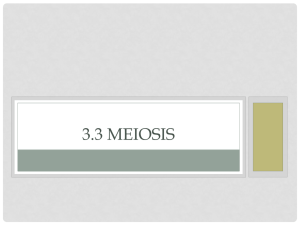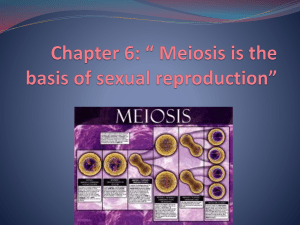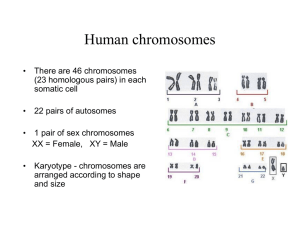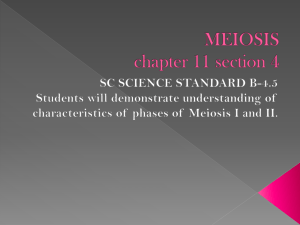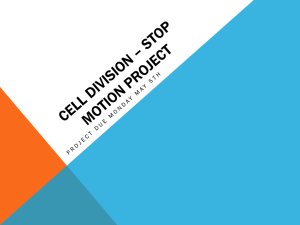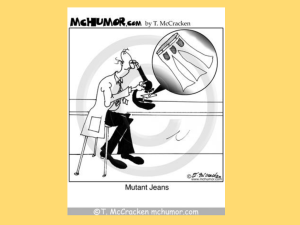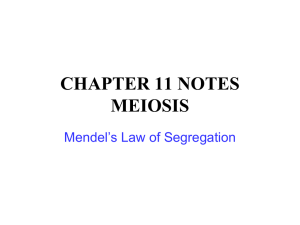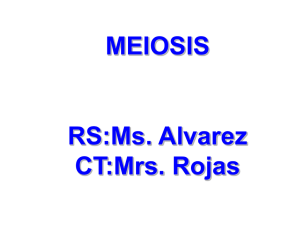Stern Chapter 12 Final PPT
advertisement
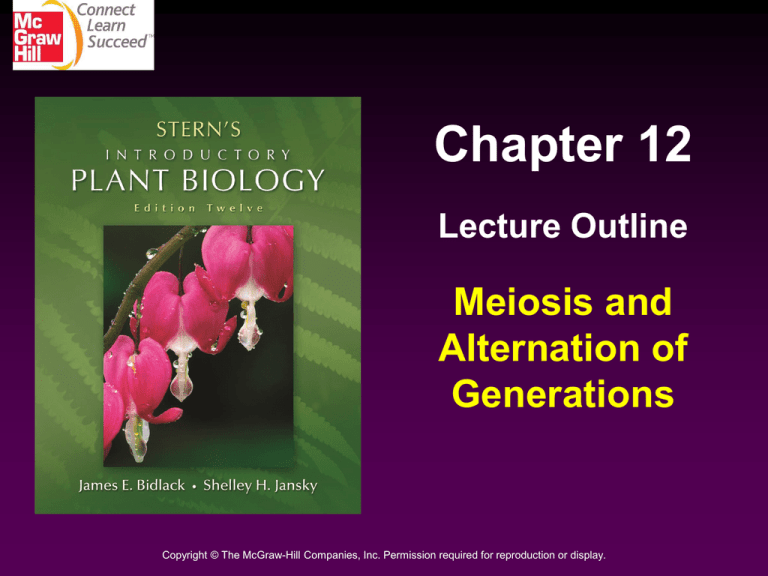
Chapter 12 Lecture Outline Meiosis and Alternation of Generations Copyright © The McGraw-Hill Companies, Inc. Permission required for reproduction or display. Outline Introduction • Asexual • Sexual Reproduction The Phases of Meiosis • Division I • Division II Alteration of Generations Introduction Asexual reproduction - Production of cells identical in chromosomes with cells from which they arose Sexual reproduction - In nearly all plants • Results in formation of seeds in flowering and cone-bearing plants • Gametes produced. – Egg and sperm unite to form zygote. Introduction Asexual and Sexual Reproduction Introduction Cells have two sets of chromosomes, one set from each parent. • Members of each pair of chromosomes are identical in: – – – – Length Amount of DNA Genes carried Location of centromere • Homologous chromosomes = chromosome pairs Results of meiosis: • Four cells from two successive divisions – – Cells with half the chromosome number of parents Each cell rarely identical to original cell or each other. The Phases of Meiosis Before meiosis, DNA molecules of each chromosome double. • Each chromosome has identical DNA molecules held together by a centromere. Meiosis: • Division I (Meiosis I or Reduction Division) - Number of chromosomes reduced to half. • Division II (Meiosis II or Equational Division) - No further reduction in chromosome number. The Phases of Meiosis Division I Prophase I • Chromosomes coil and condense, and chromosomes align in homologous pairs. – – Each homologous pair of chromosomes has four chromatids with centromere. Spindle fibers connect to centromere. • Nuclear envelope and nucleolus disassociate. • Each closely associated pair of chromosomes exchange parts = crossing-over. Chromosomes coil The Phases of Meiosis Division I Prophase I - Crossing-over • Chiasmata form. • Results in exchange of DNA by two parents Chromosomes align in pairs; chiasmata visible The Phases of Meiosis Division I Metaphase I • Chromosomes align in pairs at equator. • Spindle formation completed. The Phases of Meiosis Division I Anaphase I • One whole chromosome from each pair migrates to a pole. Telophase I • Original cell becomes two cells or two nuclei. The Phases of Meiosis Division II Similar to mitosis Prophase II Metaphase II Anaphase II Chromosomes become shorter and thicker. • Centromeres Centromeres and chromatids of each chromosome separate, and migrate to opposite poles. become aligned along equator. • New spindles completed. The Phases of Meiosis Division II Telophase II • Coils of chromatids relax and chromosomes become longer and thinner. • Nuclear envelope and nucleoli reappear for each group of chromosomes. • New cell walls form. Chromosomes at poles Formation of cell walls Alteration of Generations Haploid (1x) - Cell with one set of chromosomes • Gametes Diploid (2x) - Cell with two sets of chromosomes • Zygote Polyploid - Cell with more than two sets of chromosomes • Triploid (3x) - Three sets of chromosomes – – Homologous chromosomes cannot pair properly, thus gametes typically inviable. Navel oranges, seedless watermelons • Tetraploid (4x) - Four sets of chromosomes – Potatoes, pasta wheat Alteration of Generations Alternation of generations - Life cycle involving sexual reproduction that alternates between diploid sporophyte phase and haploid gametophyte phase • Sporophytes develop from zygotes and produce sporocytes. – Sporocyte undergoes meiosis - Produces 4 haploid spores Alteration of Generations • Gametophytes develop from spores. – Form cells or sexual structures in which gametes are formed by mitosis • Fertilization produces zygote. – Fertilization (syngamy) = Fusion of gametes Alteration of Generations First cell of gametophyte generation is a spore, and last is a gamete. Any gametophyte cell is haploid. First cell of sporophyte generation is a zygote, and last cell is a sporocyte. Any sporocyte cell is diploid. Alteration of Generations Change from sporophyte to gametophyte generation occurs as a result of meiosis. Change from gametophyte to sporophyte occurs as a result of fertilization. Review Introduction • Asexual • Sexual Reproduction The Phases of Meiosis • Division I • Division II Alteration of Generations
